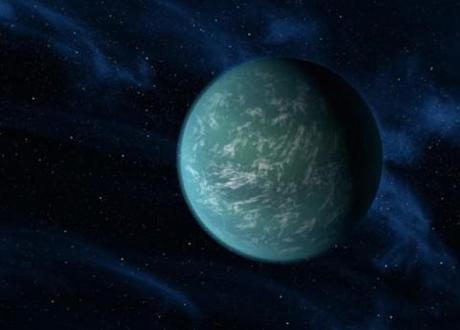
An artist's rendering of what Kepler 22-b might look like. Photo credit: NASA/Ames/JPL-Caltech
Scientists this week confirmed the existence of an Earth-like planet that is quite possibly the best chance to find life outside of our planet. The planet, Kepler 22-b, was glimpsed through the Kepler telescope, launched in 2009 by NASA on a planet-hunting mission; it evidently orbits a star like our sun and occupies a space known as the “Goldilocks zone”, an area around a star in which the atmosphere of planets are not too hot or not too cold for life to flourish. Kepler 22-b’s atmosphere reportedly has a pleasant temperature of 22 degrees Celsius.
So far, Kepler 22-b isn’t the only potential Earth 2.0 that the telescope has discovered: Of the 2326 planets it has found with the potential of harbouring life, 207 are Earth-sized and 139 have other attributes that make them the most credible candidates. Scientists, earlier this year, ranked the most liveable alien worlds. By their measures, Kepler 22-b would rank high on that list. Said Max Read at Gawker, “Guys! Twinsies!… [W]e are ready to move any minute now.” Why? Well, explained REad, though NASA isn’t quite sure, “we’ve talked to some sources who tell us that on Kepler 22-b, people are always nice to each other, all the time, and no one ever gets fat, and the subway is never late.”
But is it really Earth 2.0? If it sounds a bit like science fiction – or at least a movie that’s in theatres now – that’s because it kind of is. Though Kepler 22-b is being reported as “Earth 2.0″, many differences suggest the planet may not be habitable. For one thing, Kepler is about 15 percent closer to its sun than Earth does and scientists are unclear about the extent to which Kepler’s atmosphere is composed of gas and liquid. Chief Kepler scientist William Borucki said the planet’s atmosphere could be closer to that of Neptune, predominantly gas with only a rocky core. Kepler is also 2.4 times the size of our planet, a size that may be problematic for encouraging life. Though Kepler could harbor nascent forms of aquatic life, the focus remains on the Search for Extraterrestrial Intelligence (SETI).
“It’s a great gift. We consider this sort of our Christmas planet,” scientist William Borucki said.
Another potential Earth
Big boys on the block. In other universe news, scientists at the University of California, Berkeley reported the discovery of two “supermassive” black holes in the science journal Nature. The black holes have a mass 10 billion times that of our own Sun each. Astronomers explain that these huge black holes were formed by the merger of small ones. They sit at the center of two galaxies, known as NGC 3842 and NGC 4889, near our own. Before today’s discovery, scientists had discovered 63 ‘”supermassive” black holes but the biggest of these known to exist had a mass merely 6.3 billion times that of our puny Sun. The new discoveries will improve scientists’ understanding of how the growth of large galaxies are influenced and help them understand features of the early Universe.
We’re all going to die! Not quite. Scientists have calculated that the black holes are in galaxies more than 300 million lights years from Earth. In cosmic terms, that may be close, but for us humans the black holes are further away than we could imagine. We have our very own black hole, at the center of the Milky Way, but’s a humble one, only 4 million times bigger than our Sun.
Is it a bird? Is it a plane? No, it’s a planet. Lastly, in what has been an exciting week for scientists, images beamed back from NASA’s Dawn spacecraft, show what looks like a planet orbiting around in our solar system’s asteroid belt. Vesta, the object in question, is much larger than other asteroids and has a uniquely rugged surface. David Williams, of Arizona State University, describes Vesta as a “transitional body”, one in a state between rocky planets and the asteroids in the asteroid belt. NASA have decided to land astronauts on asteroids, instead of returning to the moon, as a stepping stone to Mars. The Independent reports that Dawn will study Vesta for several more months before cruising to an even bigger asteroid, Ceres, where it will arrive in 2015.
“Most asteroids resemble potatoes, but Vesta is more like an avocado with its iron core,” said Vishnu Reddy, mission co-scientist of the Max Planck Institute for Solar System Research in Germany.

